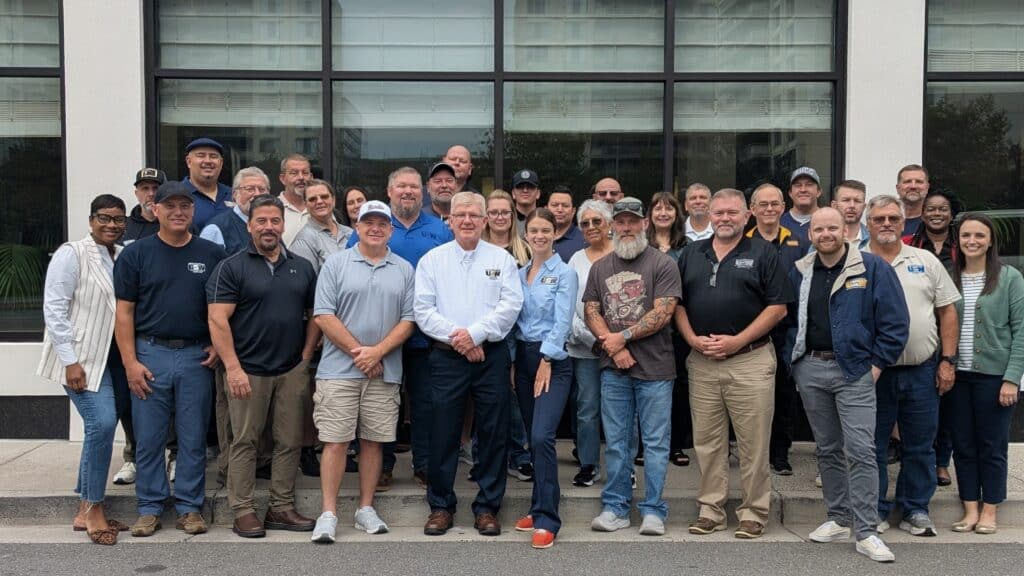Atomic Workers Harness the Power of Solidarity Amid Turbulent Political Landscape at Fall Council Meeting

The USW Atomic Energy Workers Council (AEWC) charted a worker-centered future for nuclear energy workers, helping to educate one another on relevant sector issues, including federal funding cuts, and doubling down on workforce training and worker health and safety at its fall meeting in Arlington, Va., on September 26 and 27.
AEWC Council President Gary Wilson and USW International Vice President at Large, Roxanne Brown, led the council through a packed two-day agenda that began with an overview of sector updates, including from K. Michael Goff, Deputy Assistant Secretary with the DOE Office of Nuclear Energy, and Joel Bradburne, Acting Assistant Secretary at the DOE Office of Environmental Management.
Turbulent Political Times
While the Trump administration has issued ambitious goals for the future of U.S. nuclear energy, including adding 300 gigawatts of new U.S. atomic capacity by 2050, deploying U.S. reactors for AI and military bases, and more, it’s unclear if the federal government has the funding and bandwidth to usher in the nuclear renaissance President Trump promises.
The House budget cut EM funding by $700 million, slashing funding at several USW nuclear sites while simultaneously eroding the federal workforce with staffing cuts to the DOE and several other agencies.
To boost our nation’s nuclear production, President Trump has also ordered a dangerous rewriting of radiation safety rules that would increase exposure thresholds for workers.
AEWC members jointly expressed concern to Goff and Bradburne that USW members aren’t involved in critical decisions that impact their health and safety, and resolved to continue their lobbying efforts across all levels of government to ensure the voice of labor is heard.
Workforce Development Grants Usher in Future Generation of Atomic Workers
Despite challenging political circumstances, AEWC celebrated its longstanding commitment to workforce development and the life-changing educational opportunities that enable current and potential workers to train for future employment at a DOE site.
These Community Capacity Building grants, issued by the DOE to the Steelworkers Charitable Education Organization, have already had a tremendous local impact, with hundreds of current and potential workers receiving training across several DOE sites.
Jim Rodgers, Financial Secretary of Local 550 in Paducah, Ky., said his local is training veterans and community members who are unemployed or underemployed.
“These kids are the salt of the earth, and they’re so appreciative for this opportunity,” he said. “What we’re doing is life-changing.”
Health Benefits Harmonized Across DOE Complex Contracts
The council also celebrated another positive milestone: the Portsmouth and Paducah sites joining the Steelworkers Health and Welfare Fund, which will provide better benefits and cost savings to atomic energy workers.
A meeting last year in Louisville, Ky., kicked things off as Portsmouth and Paducah had contract negotiations aligning at the same time. AEWC made a similar push for cost savings when lobbying the DOE last year.
Those efforts paid off as several local contracts are due for ratification over the next few weeks and months that have the Steelworkers Health and Welfare Fund in them. If all ratified, nearly 1,200 atomic workers will move to the union’s health plan effective January 1, 2026.
Efforts continue to streamline benefits across other DOE sites within the nuclear complex.
Retired atomic worker Herman Potter of USW Local 689 in Portsmouth, Ohio, is hopeful. “It wasn’t that long ago that the DOE said this was never going to happen,” he said.
By clicking Sign Up you're confirming that you agree with our Terms and Conditions.
Recent News Articles
Want to Learn More?
See how the USW is making a real difference in our communities and our workplaces.